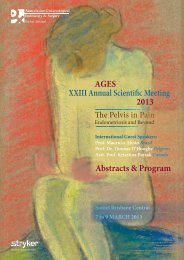to Obstetric Trauma Pelvic Floor Repair Surgical Essentials - AGES
to Obstetric Trauma Pelvic Floor Repair Surgical Essentials - AGES
to Obstetric Trauma Pelvic Floor Repair Surgical Essentials - AGES
You also want an ePaper? Increase the reach of your titles
YUMPU automatically turns print PDFs into web optimized ePapers that Google loves.
Program<br />
Abstracts<br />
Saturday<br />
4 June<br />
Session 5 / 0825-0850<br />
Dynamic episio<strong>to</strong>my and blast labial<br />
tears<br />
Rane A<br />
Cochrane review by Carolli et al ( 2004 ) recommended the use of a<br />
‘restricted’ episio<strong>to</strong>my policy. Their review suggested that there was<br />
no benefit over a ‘liberal’ use of episio<strong>to</strong>my policy as far as pain,<br />
third degree tear prevention and other issues were concerned. In<br />
that same review the last conclusion showed a 5 times increased<br />
risk of anterior perineal trauma in the ‘restricted’ episio<strong>to</strong>my group.<br />
This talk intends <strong>to</strong> discuss an ‘individualised’ policy for episio<strong>to</strong>my<br />
<strong>to</strong> reduce or prevent anterior perineal trauma and explores further<br />
understandings of ana<strong>to</strong>mical changes during the second stage of<br />
labour.<br />
The concept of ‘dynamic’ episio<strong>to</strong>my explores how and how much<br />
<strong>to</strong> cut, when <strong>to</strong> cut and when <strong>to</strong> s<strong>to</strong>p. It also explores the concept<br />
of tissue res<strong>to</strong>ration after an episio<strong>to</strong>my and how <strong>to</strong> deal with those<br />
‘blast’ tears with an ‘intact’ perineum.<br />
AUTHOR AFFILIATION: Professor Ajay Rane, James Cook<br />
University, Townsville, Queensland, Australia.<br />
Session 5 / 0850-0910<br />
Ana<strong>to</strong>my & imaging of leva<strong>to</strong>r trauma<br />
Lee J<br />
The leva<strong>to</strong>r ani is a muscular plate surrounding a central v-shaped<br />
hiatus, forming the caudal part of the abdominal envelope. It<br />
encloses the largest potential hernial portal in the human body, the<br />
‘leva<strong>to</strong>r hiatus’, containing the urethra, vagina, and anorectum. Its<br />
peculiar shape and function is a compromise between priorities<br />
that can be difficult <strong>to</strong> reconcile. Whilst abdominal contents have<br />
<strong>to</strong> be secured against gravity, solid and liquid wastes have <strong>to</strong><br />
be evacuated. In addition, and most importantly, there are the<br />
requirements of reproduction: intercourse and childbirth. The latter<br />
is the most extreme of tasks required of the pelvic floor, particularly<br />
in view of the size of the baby’s head. The leva<strong>to</strong>r ani muscle has<br />
<strong>to</strong> distend enormously, and the degree of distension required varies<br />
greatly between individuals, by at least a fac<strong>to</strong>r of 5. <strong>Trauma</strong> <strong>to</strong><br />
the puborectalis muscle as a consequence of childbirth was first<br />
reported in 1943, only <strong>to</strong> be forgotten for 60 years. It is difficult <strong>to</strong><br />
believe, but this major form of maternal birth trauma, easily palpable<br />
vaginally, and occasionally visible in the delivery suite in women with<br />
large vaginal tears is missing from general obstetric and midwifery<br />
textbooks. It is generally assumed that skeletal muscle will not<br />
stretch <strong>to</strong> more than twice its length without tearing. Hence, it is<br />
remarkable that in many women the puborectalis does not suffer<br />
any significant trauma despite much greater degrees of distension.<br />
In about half of all women there is no appreciable change in<br />
distensibility or morphologic appearance after vaginal delivery.<br />
Leva<strong>to</strong>r avulsion is the disconnection of the muscle from its insertion<br />
on the inferior pubic ramus and the pelvic sidewall, whereas tears may<br />
occur in any part of the muscle. Avulsion is a common consequence<br />
of overstretching of the leva<strong>to</strong>r ani during the second stage of labor<br />
and occurs in 10–36% of women at the time of their first delivery. It<br />
is usually occult, but has been demonstrated in the delivery suite in<br />
patients with large vaginal tears. Leva<strong>to</strong>r avulsion, although palpable,<br />
is detectable more accurately by imaging, as the lateral attachments<br />
of the leva<strong>to</strong>r ani <strong>to</strong> the pubic bone are clearly visualized. 3DTVS and<br />
3D-TPUS may be utilized <strong>to</strong> document major leva<strong>to</strong>r trauma, as can<br />
MRI. Defects are usually visualized most clearly on maximal PFMC.<br />
Tomographic ultrasound imaging is particularly useful.<br />
The functional and ana<strong>to</strong>mical consequences of leva<strong>to</strong>r ani avulsion<br />
are considerable, with a reduction in muscle strength of about onethird<br />
and marked alteration of ana<strong>to</strong>my. The main effect of avulsion<br />
is probably due <strong>to</strong> enlargement of the leva<strong>to</strong>r hiatus, but avulsion<br />
may also be a marker for other forms of trauma, such as damage<br />
<strong>to</strong> connective supporting structures (uterosacral ligaments and<br />
endopelvic and pubocervical fascia), which are currently difficult <strong>to</strong><br />
detect by imaging. An enlarged leva<strong>to</strong>r hiatus, whether congenital<br />
or due <strong>to</strong> irreversible over-distension or avulsion injury, may result in<br />
excessive loading of ligamen<strong>to</strong>us and fascial structures, which may,<br />
over time, lead <strong>to</strong> connective tissue failure and the development of<br />
prolapse. However, the role of ballooning is likely <strong>to</strong> be much more<br />
complex than that of avulsion, and it is not clear <strong>to</strong> what degree it is<br />
primary, i.e. causative, rather than secondary <strong>to</strong> POP.<br />
Using MRI, investiga<strong>to</strong>rs found that women with POP have an<br />
odds ratio of 7.3 for having a major leva<strong>to</strong>r injury compared with<br />
asymp<strong>to</strong>matic women. These data were confirmed in a larger series<br />
using TPUS. Patients with, compared with those without, a leva<strong>to</strong>r ani<br />
defect are 2.3 times more likely <strong>to</strong> have a significant cys<strong>to</strong>cele, and<br />
four times as likely <strong>to</strong> have uterine prolapse. It seems that, compared<br />
with any of the other components of the leva<strong>to</strong>r ani, trauma <strong>to</strong> the<br />
puborectalis component is most significant in affecting both the size of<br />
the hiatus and the symp<strong>to</strong>ms and signs of prolapse.<br />
11

















